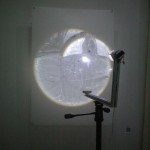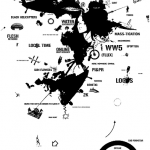Alejandro Quinteros
PhD candidate at the Planetary Collegium, CAiiA Hub, School of Art & Media, University of Plymouth
I-Node Planetary Collegium /NEXT NATURE / juried poster exhibition/ Alex Barchiesi
Dr. Alex Barchiesi
ARA (Advanced Research Associate) at the Planetary Collegium, The I-Node, School of Art & Media, University of Plymouth
No Title (2015)
Richard Feynman said, “I think it is safe to say that no one understands Quantum Mechanics.” [1]
While I strongly admire and respect Feynman, I’d like to extend the field of the so called understanding to something that is more sensual and I’ll call “field intuition” (to conceptually refer to field theories in modern physics).
We can think a human being as a highly connected organism who extends through time and space. Human experience unceasingly involves intrinsically mental and experiential functions such as “knowing” and “feeling”, involving images, intentions, thoughts and beliefs. A continuous interface holds between mind/consciousness and brain. [Mental states follow quantum mechanics during perception and cognition of ambiguous figures. arXiv:0906.4952]
Modern quantum physics has revealed that light particles seem to know what lies ahead of them and will adjust their behavior accordingly, even though the future event is not perceived as occurred yet. [T.Young: two slits experiment]
Although we perceive time as linear and unidirectional, research continues to reveal that it is not necessarily so.
One thing that is still missing and should be taken into deeper account is all the field of sensual knowledge that recently started to find his scientific formalization in neuroscientific results. Mirror neurons allow us to grasp the minds of others by feeling, not by thinking. This is shifting the understanding of culture [G. Rizzolatti – Craighero L. The Mirror-Neuron System. Annual Rev. Neurosci. 27 (2004) 169-92.] We could speculate about a possibility to extend it to certain fields of physics and science in general.
New alter – (not necessarily altered) – spaces have been rediscovered in this new era of augmented perceptions which defies our physical intuition about how the world is supposed to work.
Most working scientists hold fast to the concept of ‘realism’ – a viewpoint according to which an external reality exists independent of observation. But quantum physics has shattered some of our cornerstone beliefs. Experiments have amply confirmed quantum predictions[An experimental test of non-local realism – arXiv:0704.2529 [quant-ph]].
Our “naive physics” is actually closest to Aristotle’s 2300-year-old theories, in which heavy objects fall faster than light ones and objects in motion ease to a stop unless you keep pushing them. Quantum mechanics may seem weird, but to Aristotle, Newton’s laws would have been just as head-spinning.
The thing that’s hard is not that the people are ignorant or not ready. It’s that they already know the answer — and it’s wrong…
To get from Aristotle to Newton, you have to be able to imagine a world without friction. “It was just incredibly difficult for classical physicists to make the leap from that worldview, which was confirmed by the things they saw in the everyday world around them, to understanding the strange implications of quantum mechanics,” [Steve M. Girvin – Yale University]
In the quantum world objects resist classical banalities as “space” and “time”. Particles are waves and waves are particles, and the act of observing seems to change the system being observed.
But what if we could develop a “field intuition” that would make this all seem as natural as an apple falling from a tree?
We can develop a new and more appropriate meaning for understanding and experiencing that I advocate and will call field intuition.
The fact that our minds ‘overevolved’ and allow us also to find beauty in sunsets and mountains, waterfalls and people and outer space, and (most bizarre of all) the atomic world among other alter spaces, is a gift that we do not(in many cases) even notice.
That we can make any progress at all in understanding quantum mechanics is surprising, that we can sensually feel the quanta could be even more surprising.
www.i-node.org
I-Node Planetary Collegium /NEXT NATURE / juried poster exhibition/Andrea Traldi
Andrea Traldi
PhD candidate at the Planetary Collegium, The I-Node, School of Art & Media, University of Plymouth
Anatomy of Movement (APM) international.Country Manager – Spain
NextNature.Link (2015)
It is commonplace to organise information about experiences into temporal clusters of what ‘just happened’, ‘what happened recently’, what happened ‘previously’, and so on. One could easily be charmed into thinking that information about the past is the only kind of information one needs to understand existence. Still and all, there are different scales of information that exist in a temporal dimension and not all accounts of ‘what happens before us’ can be reduced to ‘what happened in the past’. Our generation participates in the process involving a major paradigm shift that will transform all explanations of progress based on ‘information about what happened before’ into explanations of progress made possible because of ‘information about the future’. We are building a language to transform information about the past into memories of what happens next. For every anecdote, example, and art project, there is a process of communication, a person who tells the story now, an anecdote of the present into which the story needs to introduce its meaning.For the Next Nature exhiibition, actual points in the exhibition room become a reference to incorporate information about the experience of the observer into the printed artwork.
Pictures from exhibition in KEF’15 – http://bit.ly/NextNaturePix
www.i-node.org
I-Node Planetary Collegium /NEXT NATURE / juried poster exhibition/Seth Riskin
Seth Riskin
PhD candidate at the Planetary Collegium, CAiiA Hub, School of Art & Media, University of Plymouth
Director of the MIT Museum Studio
The Physical Semantics of Light (2015)
Light as a subject of thought has proved to be impossible to deal with
holistically. Light is intrinsic to the furthest levels of physics, visual art,
philosophy, psychology, etc. The mental structures to deal with light have been
quite complex through time, cultures and disciplines, pushing against such
boundaries. The concept of light embodies many semantic and conceptual
contradictions and paradoxes, e. g., light operates in space and time which are
themselves functions of light.
I want to explore and present these contradictions in a manner by which they
may be more fully apprehended and communicated. I intend to use physical
light to reveal metaphors of light and their relationships. Combining textual
descriptions of light with optical light, physical materials, space and time will
allow me to address metaphors of light experientially and theoretically at once.
I will use text and associated concepts in ways that subject them to the same
potentials of simultaneity, spatiotemporality, etc. that light itself affords. The
research aims at combined intellectual and artistic development and
communication. It will be practice-based, resulting in a body-scale structure, or
structures (e. g., made of transparent or translucent materials, optical light and
text) that simultaneously constitutes a form of writing and physical creation,
ie., “physical semantics” of light using light
info:www.i-node.org
I-Node Planetary Collegium /NEXT NATURE / juried poster exhibition/Paola Lopreiato
Paola Lopreiato
PhD candidate at the Planetary Collegium, CAiiA Hub, School of Art & Media, University of Plymouth
Q (Quanta of Sound (2015)
Three main elements characterise the realization of this installation:
- Reconsideration of acoustic spectrum
2.Analysis and use of acoustic I electromagnetic wave phenomena
3.Use of new media
There are great similarities between the behaviour of electromagnetic wave phenomena and phenomenain the acoustic domain, and those correspondences inspired the work “0” (quanta of sounds). Theinteractive installation akes as its point of origin of the electricity distr buted in
the spectrum of audible sounds generated by the instrument (in this case the voice of audience captured by microphones),treating it and returning it with profound deviations in time and space. The energy distr bution in the spectrum of the acoustic soundis its own identity,its character, a kind of genetic code or fingerprint that makes the event unique and unrepealable. The patch configured with the software MAX I MSPis responsible for analysing the ene gy distribution (energy of sound) by dividing the spectrumin typical critical bands that are also the one with which works the basilar membrane, located in the cochlea. The energy (of the original sound) captured in the 25 critical bands will be analysed and then returnedin time in small packets (quanta) no longer in a synchronized manner but with appropriate time intervals that make more distinct and perceptible their presence,opening like a ray of light refracted by a prism. Simila/ly,the or ginal sound source (where the microphonestpeople’s voice are located) will no longer be the location (not the only one) of the •quanta of energy” which will nstead be projected in the surrounding acoustic spacein every direction. Thanks to this irradiation in time and space,the energy contained in the acoustic spectrum will be perceivable in a direct way in its essential components. The energy distribution in the spectrum of the acoustic sound is its
identity while the quantization process andirradiation of the acoustic energy in different time and
directions provide an opportunity for exploration of the sound generated by people’s voices and this process will highlighting new variations of that identity of the sound,normally trapped in the structure of the sound itself.The release of the energy within the sound and its expression through this alchemical process put in place by the new dimensions of space and time,define a new identity or better yet a different way of reading what is happening.
info : www.i-node.org







